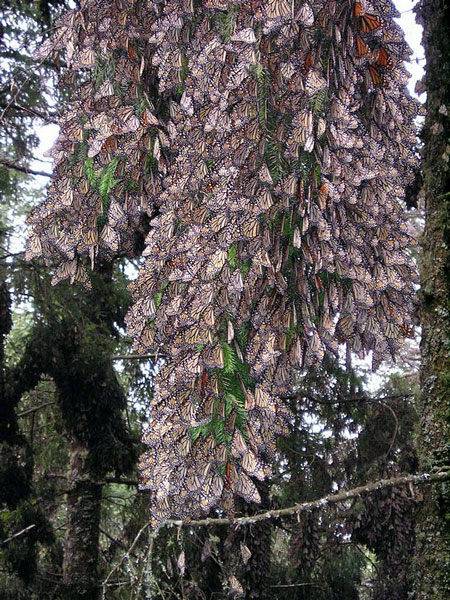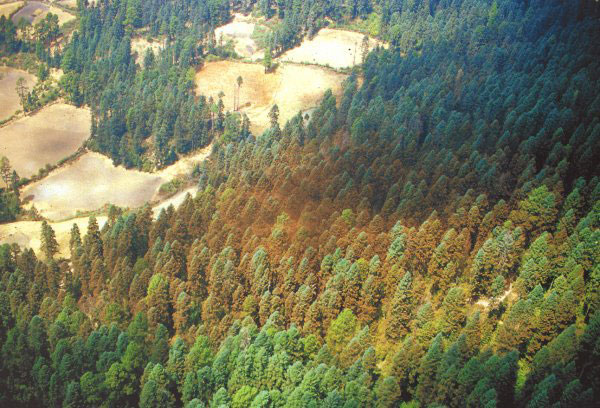Overwintering Ecology
Overview
Monarchs regularly congregate in two major regions of North America during the winter: central Mexico and coastal California (Brower 1995). They also reside in southern Florida throughout the year, but this population receives an influx of migratory individuals from the eastern migratory population each fall (Knight 1997; Altizer 2001). The degree to which monarchs from Florida move back into the larger population is not understood.
It has been generally assumed that monarchs spending the summer breeding season west of the Rocky Mountains overwinter along the coast of southern California, although the recent observations by Pyle (1999) described above suggest that there are exceptions to this pattern. The California sites are usually wooded areas dominated by eucalyptus trees, Monterey pines, and Monterey cypresses, and are located in sheltered bays or farther inland. These sites provide moderated microclimate extremes and protection from strong winds. More than 300 different aggregation sites have been reported (Frey and Schaffner 2004; Leong et al., 2004).
North American monarchs that spend the summer breeding season east of the Rocky Mountains overwinter in oyamel fir (Abies religiosa) forests in the Transvolcanic mountains of central Mexico. The location of these overwintering sites was unknown to the scientific community until 1975 when associates of Dr. Fred Urquhart located colonies on Cerro Pelón and Sierra Chincua in the state of Michoacan (Urquhart 1976; Brower 1995). Since then, several more overwintering locations have been located; colonies within the Monarch Butterfly Biosphere Reserve are found in the states of Michoacán and México (Cerro Altamirano, Cerros Chivatí-Huacal, Sierra Chincua, Sierra El Campanario and Cerro Pelón). Outside the Reserve, colonies are found in San Andres, Pizcuaro, Puerto Morillo and Puerto Bermeo (Michoacán) and Palomas, Piedra Herrada and San Francisco Oxtotilpan (México) (Garcia-Serrano et al. 2004). While scientists have learned much about the phenomenon of monarch overwintering in the past few decades, several basic questions remain. Measuring the density of an organism that congregates by the millions presents a formidable challenge. Scientists also seek to understand the characteristics of the overwintering sites that are most important to monarch survival, and the factors that influence patterns of colony formation and dispersal.
 Colony formation and dispersal
Colony formation and dispersal
Throughout the winter, North American monarchs cluster together, covering whole tree trunks and branches (Figure 13). Calvert (2004b) describes four phases typical of colony development in Mexico sites: recruitment and consolidation, settling and compaction of clusters, expansion and rapid movement, and mating and dispersal. This pattern is similar in California (Frey and Schaffner 2004). Initially monarchs occupy many local habitats, but abandon many of them by late November and join nearby colonies. Before the monarchs disperse, many of them become reproductive, and the colonies are often filled with mating pairs.
The timing of the last phase, mating and dispersal, depends on the timing of completion of reproductive diapause, which varies considerably among individuals. Goehring and Oberhauser (2004) studied post-diapause reproductive development in monarchs overwintering in Mexico. They found a great deal of variation in reproductive status of monarchs collected in late February and early March, with some butterflies fully reproductive while most were still in diapause. Females collected while mating were more likely to have developed oocytes (an indication that they were no longer in diapause) than females collected from clusters. If there is a cause and effect relationship that results in this correlation, it is not clear whether females were more likely to be mating because they were further along in their reproductive development, or if mating actually triggered the end of diapause. Both Van Hook (1993) and Oberhauser and Frey (1999) found that males which began mating first at the end of the overwintering period had shorter wingspans, were lighter, and had poorer wing condition than males that were collected in roosts at the same time. They suggest that these males are unlikely to survive the return migration north, and are thus taking advantage of their last, and only, opportunity to mate.
Overwintering densities
Scientists use many methods to estimate population sizes of insects and other animals, but determining overwintering monarch abundance is particularly challenging because of their mobility and huge numbers. Nearly 30 years after the discovery of the Mexican overwintering sites, scientists are still debating how to best estimate monarch density there. Calvert (2004b) used mark, release, recapture techniques to estimate the population densities of 7 to 61 million monarchs per ha, with higher densities occurring later in the season when the colony had contracted. At a different colony, he measured monarch density on sub-samples of tree branches and trunks to estimate 12 million monarchs per hectare. These numbers are within the ranges suggested by Brower (1977) and Brower et al. (1977), but the large variation suggests that densities probably are not constant across the season and between different colonies.
Garcia-Serrano et al. (2004) monitored 22 Mexican overwintering sites from 1993 to 2002. Using an estimate of 10 million monarchs per hectare, they found that the overwintering population ranged from 23 million monarchs in 2000-2001 to 176 million in 1996-1997 (Figure 14). They measured the highest mortality (27.7%) during a low population year (1997-1998, 45.5 million monarchs) and suggest that mortality rate may decrease with increasing population size.

Microclimate conditions in the overwintering sites
Monarchs migrate to specific overwintering sites because they require particular environmental characteristics to survive throughout the winter. Survival of overwintering monarchs in Mexico from November through March depends on a delicate balance of macro- and microclimatic factors that characterize the oyamel fir forests located within the reserve (Calvert and Brower 1986; Alonso-Mejia et al. 1992, 1997). High humidity and temperatures that fluctuate between 3o and 18o C characterize these forests, and several studies (Calvert and Brower 1981; Calvert and Cohen 1983; Calvert et al. 1982, 1983, 1984, 1986; Alonso-Mejia et al. 1992; Anderson and Brower 1993; Brower 1999) have shown that an intact forest ecosystem promotes winter survival. Butterflies in thinned forests are more likely to get wet during winter storms, and wet monarchs are unable to survive extremely cold temperatures, such as those that occurred during storms in 2002 (Brower et al. 2004) and 2004. In addition, thinned forests become colder at night because heat escapes from them more easily. Thus, an intact forest serves as both an umbrella, protecting the butterflies from snow and rain during winter storms, and a blanket, keeping the butterflies from freezing (Anderson and Brower 1996).
Recent modeling efforts (Bojórquez-Tapia 2003, Missrie 2004) show that preferred habitats of overwintering monarchs share four features: 1) high elevations (most colony sites are located at altitudes over 2890 m); 2) proximity to streams (most sites occur less than 400 m from permanent or ephemeral streams; 3) moderately steep slopes (between 23° and 26°); and 4) south-southwest orientation. In most cases, these conditions occur in oyamel fir forests, but colony sites also exist below these forests, primarily because the butterflies move to lower altitudes (where mixed forest stands occur) as spring advances.
Frey and Schaffner (2004) examined abundance on three temporal scales (spanning 1, 4 and 20 years) for western overwintering sites, using data from the California Department of Fish and Game Natural Diversity Data Base and The Monarch Program Thanksgiving Count (Marriott 2001). During the period 1997 through 2000, from 101 to 141 known sites were surveyed. Numbers of monarchs per site ranged from 0 to 120,000, with large year to year and site to site variation (Frey and Schaffner 2004). Sites near the coast that contained eucalyptus, pine and cypress tended to have more monarchs. Leong et al. (2004) found that higher monarch abundance in central California was associated with high ambient moisture, substantial morning dew and moderate winter temperatures. GIS analyses showed that most winter groves occurred within 2.4 km of the coastline, on slopes with a south to west orientation. Larger winter sites were associated with the lower slope of valleys, bays and coastal inlets. Frey and Schaffner (2004) placed their findings in a continent-wide context by making comparisons between recent population trends in the western and eastern North American populations. While the eastern population is larger than the western by at least two orders of magnitude (Brower 1985), it appears that both populations fluctuate from year to year by about half an order of magnitude. However, because no correlation between abundance in the two populations was found, their patterns may be caused by different factors.
Both Frey and Schaffner (2004) and Leong et al. (2004) advocate the use of these and similar analyses in evaluating land management practices and structuring conservation goals. Leong et al. argue that preservation of the monarch winter aggregations in California will depend on active and long-term habitat management that focuses on enhancement activities, such as tree planting, trimming and, in some cases, removal.
Winter mortality
Monarchs in the overwintering congregations in Mexico and California face numerous threats. Forest degradation and resultant changes in climatic conditions, predation by birds and mice, starvation, desiccation and freezing represent significant sources of mortality. Although monarchs are protected from vertebrate predators by the cardenolides sequestered from the milkweed they consume as larvae, any concentration of potential prey this large is likely to result in predators that evolve to overcome their defenses. Bird predation is an important cause of winter mortality, with mortality rates ranging from 1% to 18% across several colonies studied by Garcia-Serrano et al. (2004) and from 7% to 44% in colonies studied by Brower and Calvert (1985). The two main bird predators are the black-headed grosbeak (Pheucticus melanocephalus) and the black-backed oriole (Icterus abeillei). The grosbeaks consume the entire fat-rich abdomens of the monarchs, somehow tolerating the cardenolide toxins stored below the exoskeleton. The orioles slit open the abdomen with their sharp beak and scoop the contents of the abdomen and thorax out with their tongue, thus avoiding the toxins. These different prey consumption methods make it easy to distinguish which species is responsible for the deaths of monarchs found on the forest floor. At least five species of mice, the most conspicuous of which is Peromyscus melanotis, feed on butterflies that have fallen to the ground.
Extreme weather conditions, such as those caused by winter rains and snowstorms, can also kill overwintering monarchs. For example, the intense cold that followed a prolonged period of cloudy, wet weather early in 1992 may have killed up to 80% of monarchs in several overwintering colonies (Brower et al. 2004). Systematic documentation of mortality that followed another severe storm in January 2002 is reported by Brower et al. (2004). They estimated 75-80% mortality at two overwintering colonies, and suggest that similar rates occurred throughout the Mexico sites. Their estimates of the number of monarchs killed per hectare (26-72 million) far exceeded previous estimates of the number of monarchs occupying these sites, but agree with estimates presented by Calvert (2004b) for the same time of year. Oberhauser and Peterson (2003) used ecological niche modeling to delineate the environmental conditions that favor survival, and found that occupied sites exhibited cool temperatures and low precipitation during the wintering months. Unfortunately, global climate change models predict more precipitation in these areas over the next decades, suggesting that those kinds of winter storms may become more frequent.
While there is no documentation of the effects of extremely dry years on monarch survival, the fact that individuals are often observed imbibing water that collects as dew on plants or from streams or wet ground suggests that a lack of moisture would increase mortality. Likewise, little is known about factors that increase the risks of starving. Monarchs eat little during the overwintering period, so it is likely that starvation would be more likely under conditions that promote increased metabolism, such as warm ambient air temperatures, or when monarchs do not obtain enough food as larvae.
Forest dynamics and conservation of overwintering sites
The Mexican overwintering sites first achieved protected status under a 1986 presidential decree. While this was an important first step, the decree did not protect all important overwintering sites, failed to compensate local landowners for imposed restrictions on land use and offered no effective economic alternatives to previous means of subsistence (such as agriculture and logging). A consortium of geographers, monarch biologists and Mexican government officials conducted a geographic information system (GIS) analysis of deforestation that occurred between 1971 and 1999. This analysis revealed that 44% of the high quality forest present in 1971 had been degraded and fragmented, resulting in lower quality forest for overwintering monarchs (Brower et al. 2002). The rate of deforestation had accelerated over this period.
In 1998, an international group of scientists and policy makers joined to redefine the protected area and address some of the concerns with the original decree. Missrie (2004) described the 4-year process that led to a new presidential decree and improved protection of the overwintering sites. The boundaries of the expanded Reserve were determined using models based on current knowledge of the biological requirements of monarchs during the winter. As a result of the new decree, the total amount of land that was protected increased from 16,110 ha (4491 and 11,619 in the core and buffer zones, respectively) to 56,259 ha (13,552 and 42,707 ha in the core and buffer zones respectively). The new reserve protects a contiguous area of land, instead of the separate "islands" of land that were protected by the old decree (Missrie 2004). However, as is the case with all conservation laws, effectiveness requires enforcement of the law, and logging and forest degradation are still occurring.
Keiman and Franco (2004) studied the response of the Mexican oyamel fir forests to disturbance. Their finding that trees within forest patches tend to be similar in size, and that homogeneity tends to increase with stand age, along with the fact that monarchs typically form colonies in mature forests, suggests that it will be important to ensure replacement as forest patches age.
